Birthday conference for Richard Rimanyi
Birthday conference for Richard Rimanyi
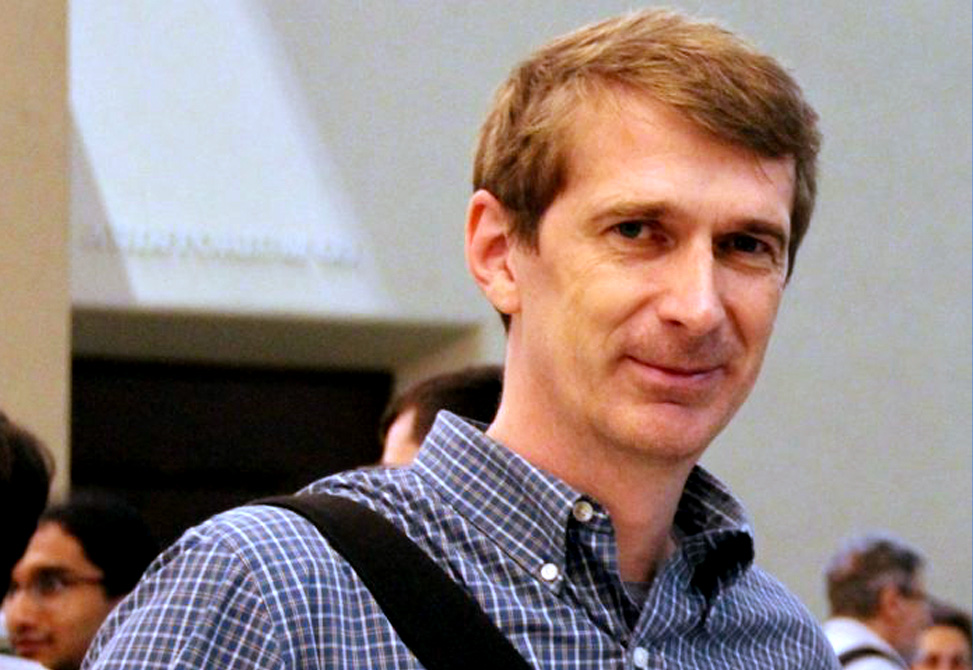
A conference titled “Characteristic Classes and Singularities” will be held in honor of Richard Rimanyi on the occasion of his 50th birthday. The conference will be hosted at the University of Geneva, Geneva, Switzerland October 4-7 2018. See the conference webpage for more details.
Professor Richard Rimanyi is the Bowman and Gordon Gray Distinguished Term Professor in the Department of Mathematics, and has been on the mathematics faculty since 2003.
Metcalfe Awarded for Excellence
Metcalfe Awarded for Excellence

Jason Metcalfe meets with a student during office hours in Phillips Hall
Congratulations to Jason Metcalfe, Professor in the Department of Mathematics, who has been awarded the 2018 Board of Governors Award for Excellence in Teaching. Each year, the award is presented to a tenured faculty member on each campus of the UNC System for excellent and exceptional undergraduate teaching over a sustained period. The Ottoville, Ohio native told us about his teaching experiences.
No other teacher has cared more about my understanding of the material nor put as much effort towards making a course this challenging into manageable, but still intellectually engaging, work.
-Excerpt from award citation
Who was the best teacher you ever had and why?
Professor Aparna Higgins at the University of Dayton stands out. She held her classes to the highest expectations, yet her students were always supported to the fullest. Her office hours were welcoming, her explanations were patient, and her encouragement was unwavering. Her mastery of challenging students and inspiring them to actively engage with the subject while providing the utmost support is something that I aspire to emulate.
Describe an “Aha!” moment you had when learning how to teach students.
A pair of students came to office hours to work on an assignment, and they were off to a very good start. Their remaining obstruction was well within their abilities. Though I wanted to give them a hint, I just encouraged them to keep trying. I believe that they learned more about the material in that 20 minutes of struggling on their own than they would have with hours of “help” from me. Ever since, I remind myself often not to say too much.
Describe a time when you learned something from a student.
My favorite thing to see is when a student correctly implements a strategy that had not occurred to me. Several memory aids for trigonometry were taught to me by students. A guide that I teach for learning integration by parts is something that I found in a student’s scratch work on an exam.
What is something your students would be surprised to learn about you?
I did not take calculus in high school, as it wasn not offered at the time at my small school, and seeing the rigorous definition of limit on my first day of college almost caused a panic attack.
Story by Korie Dean, University Gazette
UNC Graduate Paul Cornwell
UNC Graduate Paul Cornwell
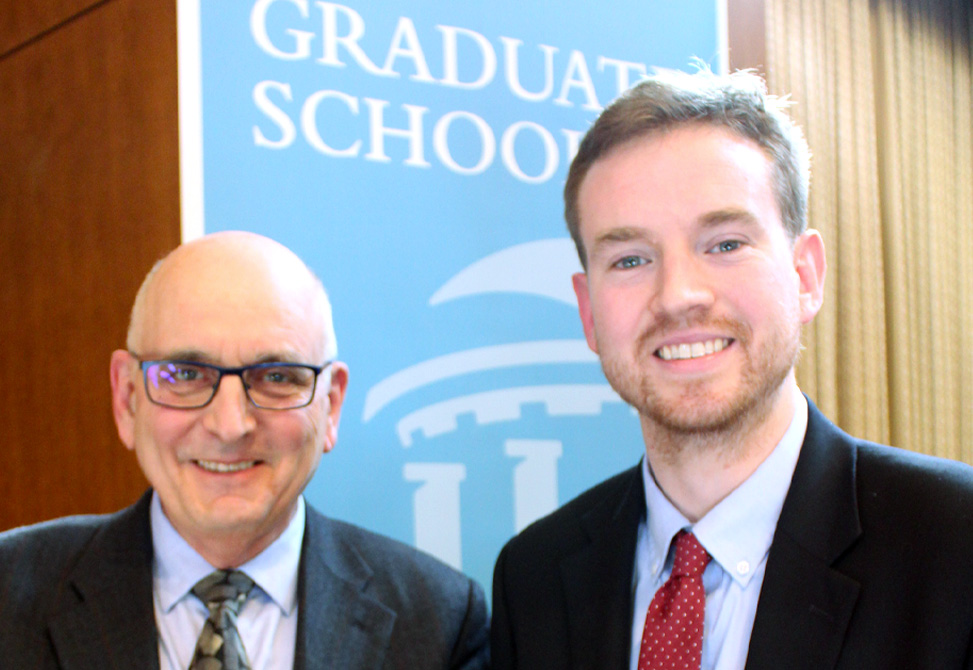
Congratulations to one of our very own, Paul Cornwell, for being a recipient of the 2018 Dean’s Distinguished Dissertation Award in the area of Mathematics, Physical Sciences, and Engineering. His dissertation, titled “A Symplectic View of Stability for Traveling Waves in Skew-Gradient Systems, ” was written under the advising of Professor Christopher Jones.
The Department is very proud of you, Paul!
Bernardi and Morgan Awarded
Bernardi and Morgan Awarded
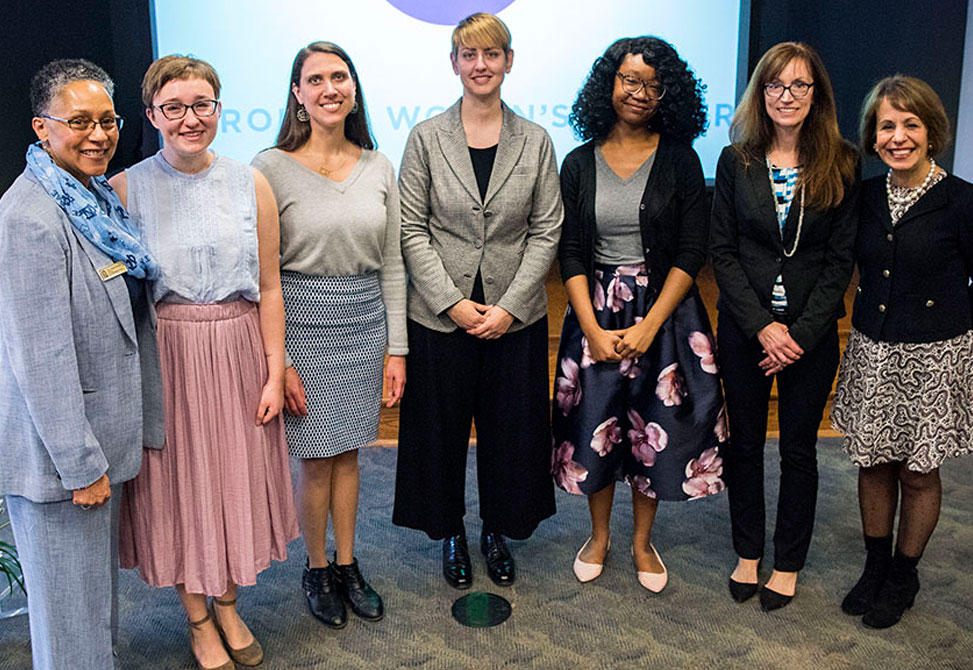
Pictured from left to right: Gloria Thomas, Emily Hagstrom, Katrina Morgan, Francesca Bernardi, Erica Wallace, Marcey Waters and Chancellor Carol L. Folt
Graduate students Katrina Morgan and Francesca Bernardi, from the Department of Mathematics, were honored as the co-founders of Girls Talk Math, a two-week summer day camp to encourage high school girls to consider careers in mathematics. At the camp, the students explore interesting mathematical concepts, learn about the rich history of women in mathematics and create a blog and podcast series. The camp will meet on campus for the third time this summer.
The University Awards for the Advancement of Women honor individuals who have mentored or supported women on campus, elevated the status of women or improved campus policies for them, promoted women’s recruitment and retention, or promoted professional development for women.
“We all have more power than we think we do,” Morgan said. “No matter who you are, you’re capable of making an impact.”
Congratulations to Katrina and Francesca!
Katrina Morgan Graduate Fellow
Katrina Morgan Graduate Fellow
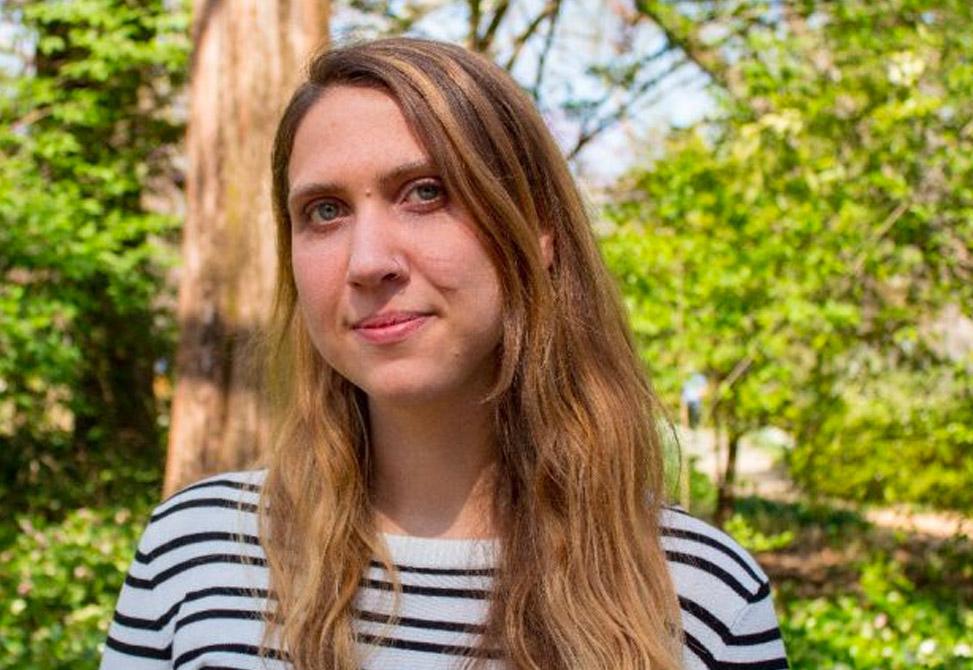
Katrina Morgan, a Ph.D. candidate in the Department of Mathematics, has been selected in the inaugural cohort of Kenan Graduate Fellows in the College of Arts & Sciences. One of only ten graduate students in the college chosen for this fellowship, Katrina has distinguished herself as an outstanding researcher and teacher, and will serve as an ambassador in sharing her story with prospective students the college hopes to recruit.
A generous gift from alumnus Thomas S. Kenan III, ’59, funds the Thomas S. Kenan III Graduate Fellows Program. Kenan is passionate about funding graduate students at a level that enables them to be fully immersed in their scholarship and realize their potential. This new program will help some of the College’s most talented graduate students work toward completion of their doctorates. The ten students in the first cohort of this program will receive a $5,000 top-up to their regular stipend in 2018-2019 and a $2,500 summer stipend in either 2018 or 2019.
Congratulations, Katrina!
Canzani Sloan Research Fellow
Canzani Sloan Research Fellow
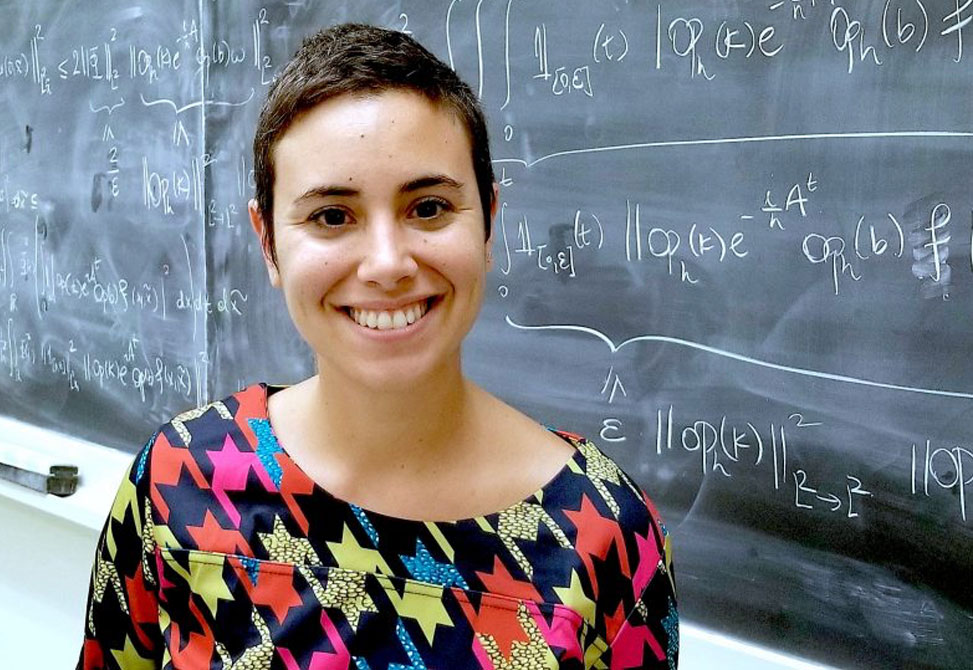
Yaiza Canzani, an assistant professor of mathematics in UNC’s College of Arts & Sciences, has been awarded a 2018 Sloan Research Fellowship.
The fellowships are given to early-career scientists and scholars whose achievements and potential identify them as “rising stars,” the next generation of scientific leaders. The recipients are recognized for being among the very best scientific minds working today. Winners receive a two-year $65,000 fellowship to further their research.
The Alfred P. Sloan Foundation announced the selection of 126 new Sloan Fellows from 53 colleges and universities in the United States and Canada on Feb. 15. The fellowships have been awarded yearly since 1955. The Sloan is among the most prestigious awards given to young scholars.
“The Sloan Research Fellows represent the very best science has to offer,” said Sloan President Adam Falk. “[They are] the brightest minds, tackling the hardest problems, and succeeding brilliantly – Fellows are quite literally the future of 21st century science.”
Canzani’s research is dedicated to studying solutions to the Schrödinger equation, which is a mathematical formulation derived by the physicist Erwin Schrödinger in 1926. This equation describes how a quantum system evolves over time. Her research focuses on understanding the behavior of wave functions that solve Schrödinger’s equation – the mathematical formulation for studying the energy levels of quantum mechanical systems like atoms.
The Sloan Fellowship will allow her to dedicate more time to this complex research as well as collaborating on this project with several colleagues.
Forty-five previous Sloan fellows have received a Nobel Prize in their respective field, 16 have won the Fields Medal in mathematics, 69 have received the National Medal of Science, and 17 have won the John Bates Clark Medal in economics, including every winner since 2007.
Richard McLaughlin, chair of the mathematics department, said this is exciting news because the last time the department had a Sloan Fellow was about 10 years ago.
“Yaiza’s remarkable results on the Schrödinger equation bridge many areas of mathematics and physics, including partial differential equations, geometry, statistical mechanics, random matrix theory, quantum mechanics and number theory,” McLaughlin said.
Canzani was previously a Benjamin Peirce Fellow at Harvard University and a member of the Institute for Advanced Study. She received her Ph.D. from McGill University.
Canzani in Endeavors
Canzani in Endeavors
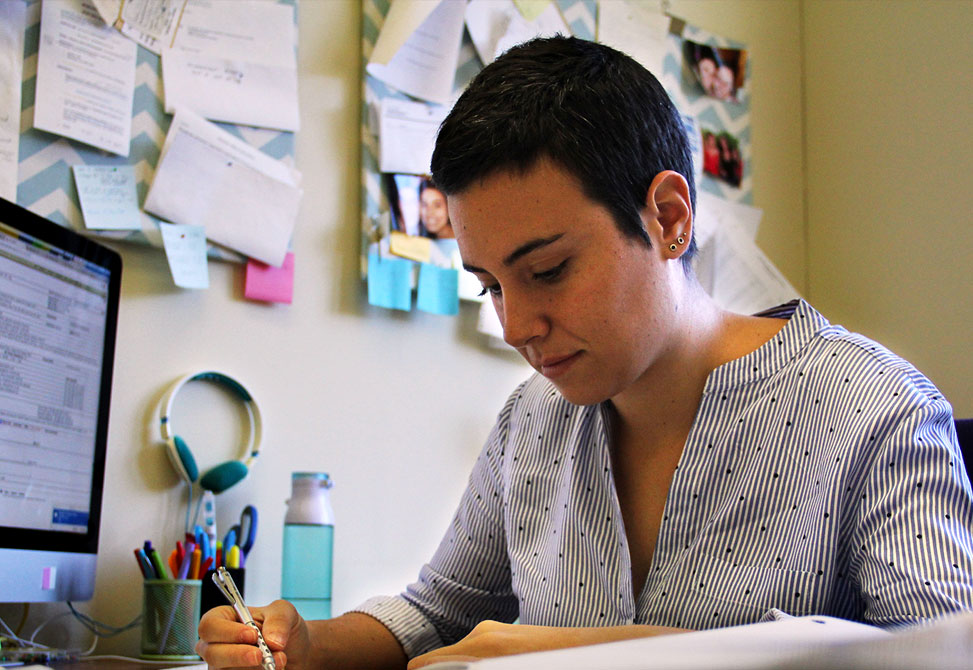
Yaiza Canzani is an assistant professor in the Department of Mathematics within the UNC College of Arts & Sciences. Her research focuses on understanding the behavior of wave functions that solve Schrodinger’s equation – the mathematical formulation for studying the energy levels of quantum mechanical systems like atoms.
When you were a child, what was your response to this question: “What do you want to be when you grow up?”
When I was younger, it was much easier for me to think about what I didn’t want to be. I knew, for example, that I would never end up doing anything related to sports – I’m too much of a couch person!
Describe your research in five words.
Quantum particles avoid my zeros.
Share the pivotal moment in your life that helped you choose your field of study.
I come from Uruguay, and over there you choose your career when you are 18 years old. Then, you spend the four years of your undergrad taking courses directly related to your election. I think I was too young to make such a decision. What I knew at the time was that I was good at math, and that I really liked chemistry.
There is only one public university in Uruguay, and the buildings for the different careers are spread across the capital, Montevideo. I chose to do math because the math department was a ten-minute walk from home, while the chemistry building was an hour away by bus, ha! I was eighteen – what can I say?! After starting the career in math, though, I realized that I loved it, and it became clear to me that doing research in math would lead me to a happy life. So I kept going.
Tell us about a time you encountered a tricky problem. How did you handle it and what did you learn from it?
The first draft of a blog post I published with Scientific American came back from the editor with a note at the top saying something like: “I stopped writing comments because there would be too many, and they would all say the writing sounds too much like a textbook. It should be conversational, and I really hope that’s not how you talk!” I had to laugh at the criticism, because I knew it was true! Somewhere along the line I had decided this style of writing made me sound smart. But I realized my goal in the piece was to communicate with people, not to impress them, which meant writing something they might actually want to read.
What are your passions outside science?
Throughout most of graduate school, I volunteered with Girls Rock NC, a youth empowerment program for girls and gender-variant youth. I’ve been less involved since co-founding my own summer camp, Girls Talk Math, though I was able to collaborate with them by having their teen group write and record an intro song for our campers’ podcasts. It’s important to me to stay connected with and help the community around UNC. Research can sometimes feel isolated from the rest of the world, but academics are community members just like anyone else.
Women in Science Wednesday highlights UNC researchers at all levels of their careers across dozens of fields. From nursing to economics to computer science, women at Carolina excel in research, mentorship, and advocacy.
Story by Endeavors, January 10th, 2018, Women in Science Wednesdays
Katrina Morgan in Endeavors
Katrina Morgan in Endeavors
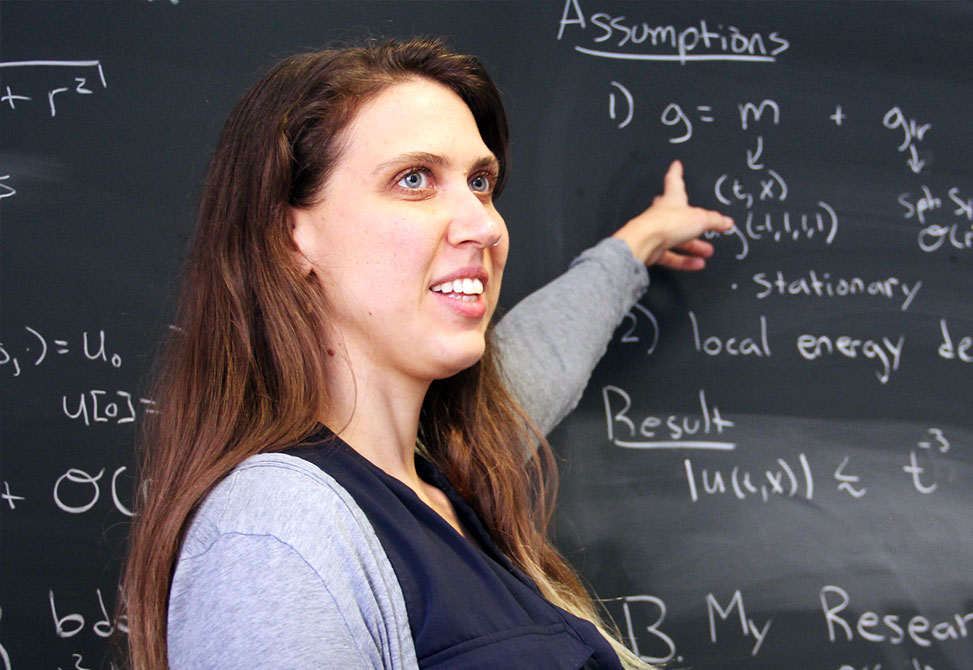
Katrina Morgan is a fourth-year PhD candidate studying mathematics within the UNC College of Arts & Sciences. Her research is motivated by General Relativity, which says our universe bends near massive bodies like planets or black holes and becomes flat away from them. She examines how light waves decay on a variety of spacetimes that are curved, but become flat far away in space.
When you were a child, what was your response to this question: “What do you want to be when you grow up?”
In third grade, I wanted to be a teacher. But, eventually, it occurred to me that teachers’ days didn’t look quite like mine. They taught the same class multiple times each day – and they definitely didn’t get recess! I like teaching, but I love that academia also allows me to do research and other projects.
Describe your research in five words.
Light waves on bendy universes.
Share the pivotal moment in your life that helped you choose your field of study.
I come from a math family. My dad has a Ph.D. in math, and my mom had a dual master’s degree in math and physics. They always talked about math as being creative and dynamic, which was often not what I got from my math classes in primary school. Their enthusiasm for the subject helped me develop my own love of mathematics.
Tell us about a time you encountered a tricky problem. How did you handle it and what did you learn from it?
The first draft of a blog post I published with Scientific American came back from the editor with a note at the top saying something like: “I stopped writing comments because there would be too many, and they would all say the writing sounds too much like a textbook. It should be conversational, and I really hope that’s not how you talk!” I had to laugh at the criticism, because I knew it was true! Somewhere along the line I had decided this style of writing made me sound smart. But I realized my goal in the piece was to communicate with people, not to impress them, which meant writing something they might actually want to read.
What are your passions outside science?
Throughout most of graduate school, I volunteered with Girls Rock NC, a youth empowerment program for girls and gender-variant youth. I’ve been less involved since co-founding my own summer camp, Girls Talk Math, though I was able to collaborate with them by having their teen group write and record an intro song for our campers’ podcasts. It’s important to me to stay connected with and help the community around UNC. Research can sometimes feel isolated from the rest of the world, but academics are community members just like anyone else.
Women in Science Wednesday highlights UNC researchers at all levels of their careers across dozens of fields. From nursing to economics to computer science, women at Carolina excel in research, mentorship, and advocacy.
Story by Endeavors, January 10th, 2018, Women in Science Wednesdays
Fluid Labs News
Fluid Labs News
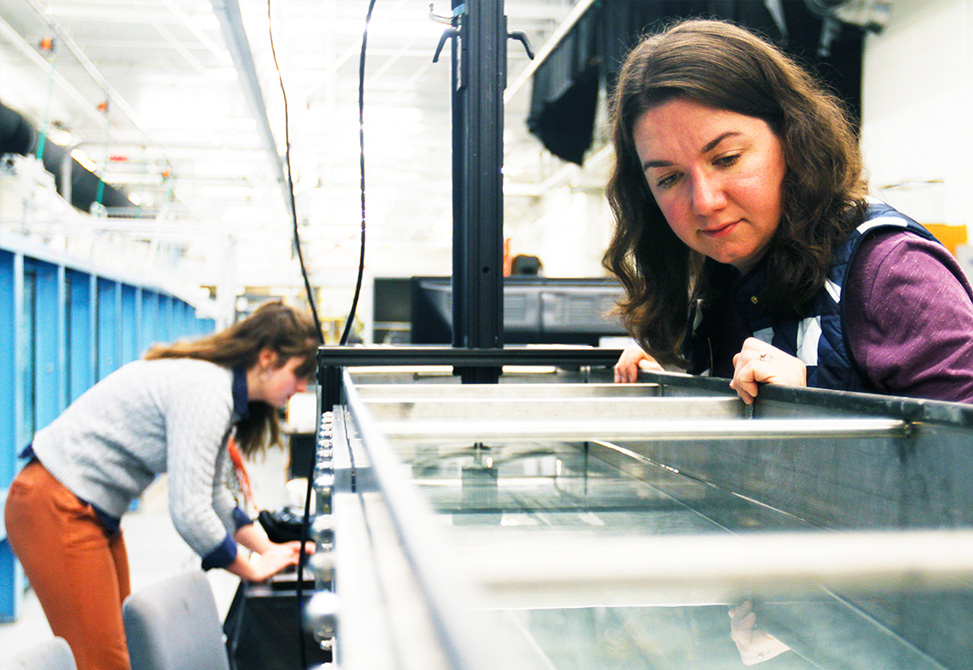
Kaylyn Gootman observes the water in the racetrack flume, as her undergraduate research assistant Savannah Swinea sets the Acoustic Doppler Velocimeter, ADV.
Streambeds act as natural water filters by trapping particles and pollutants. To better understand the dynamics of these small yet complex systems, a UNC hydrologist is creating, and clogging, her own stream.
The basement of Chapman Hall is a maze. Wind through several hallways, swipe a UNC OneCard to gain access through a heavy, locked door, and enter the massive chamber of the Joint Applied Math and Marine Sciences Fluids lab.
Turn left, walk past the wind tunnel and the towering 36-meter wave tank, and you’ll see hundreds of gallons of water swirling through an elevated metal structure. Kaylyn Gootman, a PhD candidate in the Curriculum in Environment and Ecology, dumps a large plastic bag full of what looks like flour into the water and watches closely as the contents disperse.
The large oval-shaped metal structure, called a racetrack flume, holds approximately 430 gallons of water, the equivalent of about eight bath tubs. Using an electric trolling motor and an Acoustic Doppler Velocimeter, ADV, Gootman can control the direction and speed of the water. The material that looks like flour is actually finely ground clay – and Gootman is very interested in how it moves.
Gootman calls the set-up a “mock stream.”
“We’re studying the physical impact of a natural pollutant – like how much clay gets embedded in a streambed – and the natural clean-up processes that the water circulation of a stream provides,” she says.
Water movement is complex – in a natural stream, water flows up, down, and all around. To understand the whole system, Gootman, and her undergraduate assistant Savannah Swinea, are examining the individual processes of a stream they built here in the fluids lab.
“Being able to narrow our focus to major physical controls allows us to study a few key processes without much interference,” Gootman says. “That knowledge can then act as a foundation for better understanding in the natural environment where things happen in multiple directions and dimensions all at once.”
Constructing a Stream
Think of a streambed as a kidney. “Kidneys filter blood, and streams filter water – both trap toxins,” Gootman says. While kidneys filter toxins like alcohol, streams break down particles from surface water runoff including pollutants from irrigation, construction, or industrial agriculture. But just as kidneys can fail, so can streams – a kidney stone is akin to a clogged streambed.
Gootman’s research can help geoscientists, developers, and land owners better understand erosion events, especially as they relate to urbanization. How much pollution can a stream filter before the system gets overwhelmed?
Working in the fluids lab allows her to save time and resources – and she’s not harming the environment. “Going out to a stream and dumping a bunch of clay in it would not be very good environmental stewardship,” Gootman says with a smile.
Using a contained system like the racetrack flume also gives her the ability to obtain precise measurements. Gootman can focus on one particular direction of water movement, like down-welling, or the downward flow of water into the streambed. Examining each parameter individually simplifies the inherently complex nature of fluid dynamics.
Obstructing a Stream
Turbidity, or the level of “cloudiness” in the water, is another important indicator when measuring quality – but it’s a difficult measurement to obtain in natural streams. “The most accurate way to measure turbidity is to take samples, then go back to the lab to filter them,” Gootman says. “And you have to do that a lot. It’s really expensive and time consuming.”
But there are other methods for measuring turbidity, including optical sensors. “Optical back scatter” is a technical term used by hydrologists that refers to the use of light to determine how much material is in a body of water. Optical backscatter sensors, OBS, emit infrared light into the water column. As soon as the light comes into contact with suspended particles, it bounces back to the sensor. Faster signals indicate more particles in the water.
Gootman and other hydrologists measure the optical back scatter in river networks all over the world, but no two rivers are the same. “It’s very location specific work – a calibration for the Haw River is different from the Mississippi,” she says. “That’s another advantage of working in the fluids lab – we can make these kinds of calibrations more accurately and easily than we can in the field.”
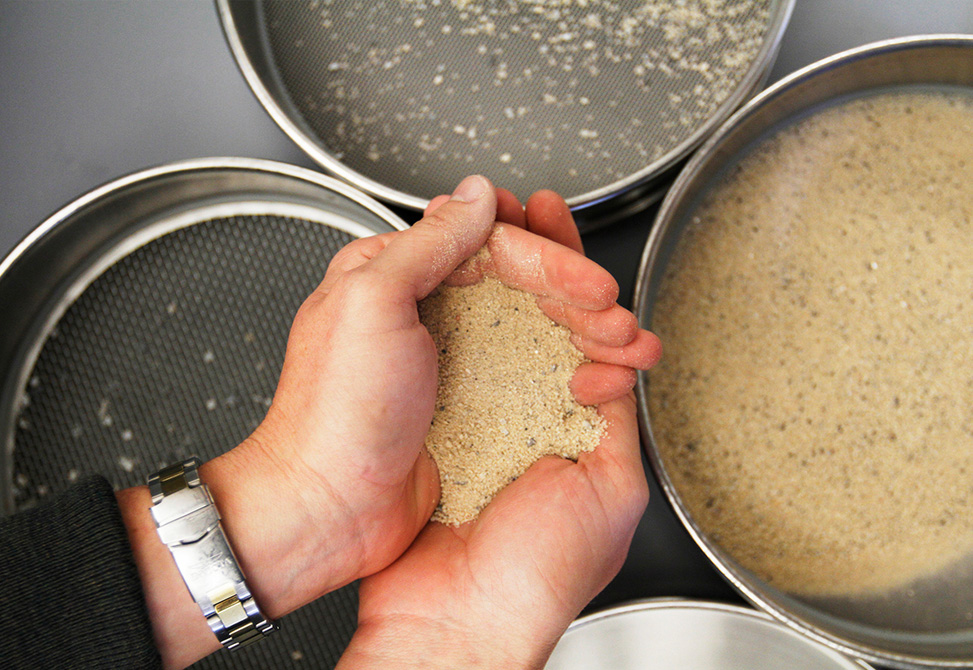
Gootman holds some of the sand she and Swinea use to “clog” their stream.
Decoding the Data
The value of this kind of high-tech instrumentation is it records every tiny signal – the downside is it records a lot of data. On paper, it looks like a jumbled mess. “The instrumentation is so sensitive it’s almost like earthquake data,” Gootman says. To make sense of it, Gootman meets with UNC’s resident earth science data expert and chair of the Department of Geological Sciences, Jonathan Lees. “He’s helped me discern the signal from the noise,” she says.
In addition to decoding her backscatter data, Gootman analyzes the migration of clay particles by examining sediment cores. “How deep clay particles travel into the streambed tells us a lot about the physics of the water in the stream,” she says. “You might not think that a tiny thing like bits of clay could have a large impact but enough of it over a certain amount of time could.”
Gootman and Swinea spend hours separating the sediment cores by hand in the lab – but that only gets them so far. Fortunately, Gootman can borrow a laser particle size analyzer from Laura Moore, director of the UNC Coastal Environmental Change Lab.
In addition to utilizing the resources and expertise of the Department of Geological Sciences, Gootman also collaborates with faculty in math, physics, and marine sciences. “This is inherently collaborative work,” she says. “And it has also afforded me the opportunity to be a mentor.”
Blazing a Trail
As a junior pursuing a major in environmental science and a minor in marine science, Swinea knew she wanted to get experience with hands-on research.
“I was looking for research opportunities for the summer and realized that UNC has a program for students in the geosciences from underrepresented communities,” Swinea says. The IDEA Undergraduate Research Experience, a program funded by the National Science Foundation, matched Swinea with Gootman and the two women have created a strong partnership.
The collaboration has given Swinea experience and research skills she didn’t have before this past summer. “Learning how to program a probe or use a test tube is useful, but the biggest things I’ve learned from Kaylyn are being adaptable and being patient – those are overarching qualities that you don’t necessarily learn in a class.”
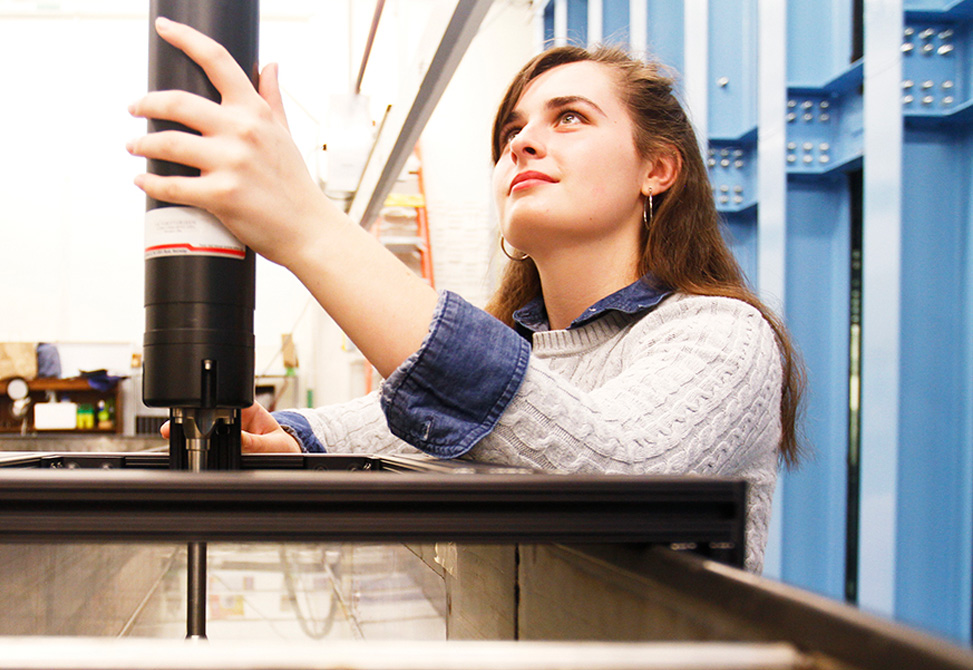
Swinea holds the ADV steady as Gootman begins to fill the flume with water.
Swinea’s enthusiasm and eagerness to learn also inspires Gootman. “It’s really cool to see a woman who is younger than me on the early part of her scientific path,” she says. “Savannah is a great student – she’s curious, she’s a quick learner and she’s not afraid to ask for help when she’s stuck. And she’s getting started with research much earlier than I did.”
One of the greatest strengths of their work together, and one of the most vital things for Swinea, has been seeing herself in Gootman. Because Gootman also went to UNC for undergrad, Swinea can visualize a similar trajectory for herself. “Kaylyn has given me a lot of advice about academia and grad school and life decisions,” she says. “What’s kept me on the science path is not only teachers and peers encouraging me – it’s being able to see myself in the future.”
As Swinea contemplates the possibilities associated with a career in science, Gootman considers impact of the research they’re currently conducting together. “There are lots of things happening to our rivers and streams as housing developments and commercial developments increase,” she says.
The work Gootman and Swinea are doing in the fluids lab will one day help inform issues like bank erosion, excess runoff, and water quality. “Our data provides information on the baseline physical dynamics of streams – how water functions as a filter,” Gootman says. “Having that information on hand can help us target places to study out in the real world.”
Story by Mary Lide Parker, Endeavors Magazine, 2017
Rudy Horne In Memoriam
Rudy Horne In Memoriam
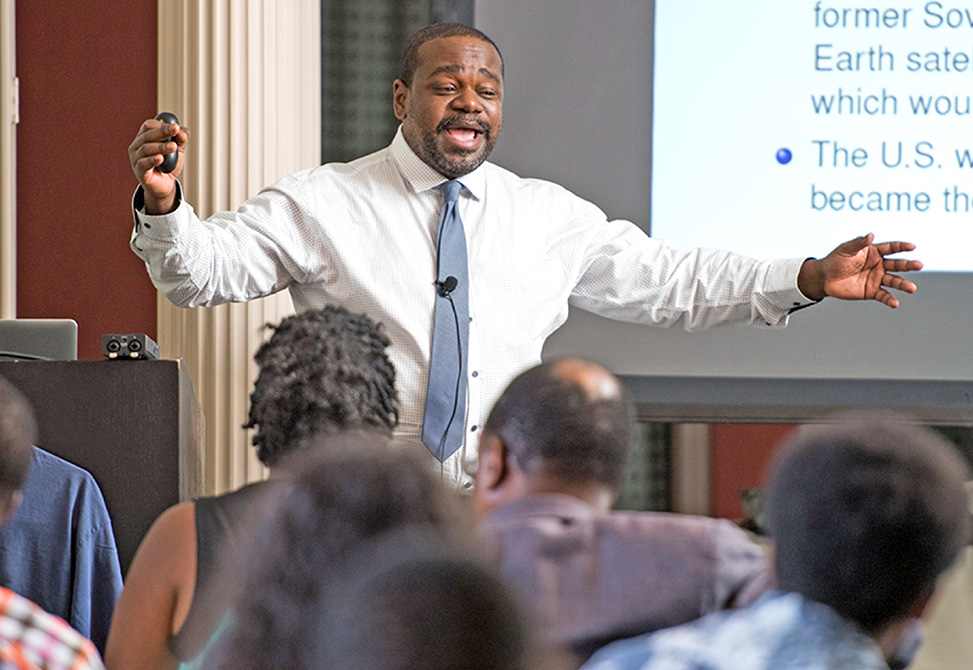
Horne delivering the Blackwell–Wilkins Keynote Address at CAARMS 2017
It is with great sadness that we share the news of the passing this week of Rudy Horne, who was a postdoctoral fellow in Mathematics at UNC from 2002 until 2005. Rudy was a person with enormous spirit and he cheered us everyday he was in the Mathematics Department at Carolina.
Horne grew up in the south side of Chicago. His father worked at Sherwin-Williams, and Rudy graduated from Crete-Monee High School. He completed a double degree in mathematics and physics at the University of Oklahoma in 1991, and joined the University of Colorado Boulder for his postgraduate studies. Rudy earned a master’s degree in physics in 1994 and in mathematics in 1996. He completed his doctorate, Collision Induced Timing Jitter and Four-Wave Mixing in Wavelength Division Multiplexing Soliton Systems, in 2001, supervised by Mark J. Ablowitz. He was the first African American to graduate from the University of Colorado Boulder Department of Applied Mathematics.
Rudy was most recently an Associate Professor at Morehouse College, teaching and inspiring undergraduates there to pursue athematics. His research was in nonlinear optics and he was known for uncovering effects in PT symmetric systems as well as his earlier work on four-wave mixing.
In 2016, Rudy worked on the production of the movie “Hidden Figures” as a mathematics consultant. The movie centers on three African-American women who played key roles in the US space program. Rudy’s role was to ensure the credibility of the mathematical ideas discussed and written on the blackboards during the movie. He was scheduled to deliver a public lecture at UNC in October about his experience participating in the creation of the movie, but had to cancel due to ill-health.
